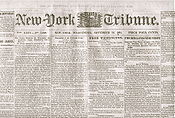- New York Tribune
-
The New York Tribune 
The November 16, 1864 issue of the
The New York TribuneType Daily newspaper Format Broadsheet Founded 1841 Ceased publication 1966 Headquarters New York, New York, U.S. The New York Tribune was an American newspaper, first established by Horace Greeley in 1841, which was long considered one of the leading newspapers in the United States. In 1924 it was merged with the New York Herald to form the New York Herald Tribune, which ceased publication in 1966.
Contents
History
Greeley had previously established a weekly newspaper, The New Yorker (unrelated to the modern magazine), in 1833, and was also publisher of the Whig Party's political organ, Log Cabin. In 1841, he merged operations of the two into a new newspaper, The New York Tribune.
The Tribune was created by Greeley with the hopes of providing a straightforward, trustworthy media source in an era when newspapers such as the New York Sun and New York Herald thrived on sensationalism. Although considered the least partisan of the leading newspapers, the Tribune did reflect some of Horace Greeley's idealist views. His journal retained Karl Marx as European correspondent in 1852; although Marx viewed the Tribune as a 'filthy rag',[1] the arrangement, whereby his collaborator Engels also submitted articles under the by-line, lasted ten years, the final Marx column being published in February 1861.
During Greeley's editorship, the paper was aided by able writers including Charles Anderson Dana, George William Curtis, William Henry Fry, Bayard Taylor, Margaret Fuller, George Ripley, Julius Chambers and Henry Jarvis Raymond.[2]
Before the American Civil War the Tribune was an important abolitionist newspaper due to its firm stance against slavery and having the largest circulation of any abolitionist newspaper. During the American Civil War (1861–1865) the Tribune was a radical Republican newspaper, which supported abolition and the defeat of the Confederacy[citation needed] instead of negotiated peace.[citation needed]
During the first few months of the war, the paper's "on to Richmond" slogan pressured Union general Irvin McDowell into advancing on Richmond before his army was ready, resulting in the disaster of the First Battle of Manassas on July 21, 1861. After the failure of the Peninsular Campaign in the spring of 1862, the Tribune pressured President Abraham Lincoln into installing John Pope as commander of the Army of Virginia. During the 1863 Draft Riots a mob tried to burn down the Tribune building but was repulsed by staff manning two Gatling guns.[citation needed]
Following Greeley's defeat by Ulysses S. Grant for the presidency of the United States in 1872, Whitelaw Reid, owner of the New York Herald, assumed control of the Tribune. Greeley checked into Dr. Choate's Sanitarium where he died a few weeks later. Under Reid's son, Ogden Mills Reid, the paper acquired the New York Herald to form the New York Herald Tribune, which continued to be run by Ogden M. Reid until his death in 1947. Copies of the New York Tribune are available on microfilm at many large libraries. Indices from selected years in the late nineteenth century are available on the Library of Congress' website. The original paper articles from the newspaper's morgue[clarification needed] are kept at The Center for American History at the University of Texas at Austin.
New paper, same name
A "new" New York Tribune debuted in 1976 in New York City. The paper, which later changed its name to The New York City Tribune, was published by News World Communications, Inc., owned by the Unification Church. It was published out of the former Tiffany building at 401 Fifth Avenue until it printed its last edition on January 3, 1991.[3] Its sister paper, The Washington Times, is circulated primarily in the nation's capital. The Tribune carried an expansive "Commentary" section of opinions and editorials. Among those who wrote a column was former New York City Mayor Ed Koch.
Former Tribune buildings today
- The New York Tribune building was the first home of Pace University. Today, the site where the building once stood is now the One Pace Plaza complex of Pace University's New York City campus. Dr. Choate’s residence and private hospital, where Horace Greeley died, today is part of the campus of Pace University in Pleasantville, New York.
- On December 15, 1921, The New York Tribune bought two plots of ground at 219 and 220 West 40th Street. The headquarters that The New York Tribune built at that site is now the home of the City University of New York Graduate School of Journalism.
In popular culture
- The Tribune was referenced in one rendition of the popular 19th-century ballad, "No Irish Need Apply",[4] as performed by Tony Pastor, as the paper of choice of the anti-Irish antagonist in the song.[citation needed]
References
Bibliography
- New York Tribune Index, 1875-1895 U.S. Library of Congress
- Spartacus Education Brief history from the U.K.
- The New York Tribune - A Sketch of Its History Book from 1883
- Vaughn, Stephen L. (editor) "Encyclopedia of American Journalism" (Routledge, 2009), pg. 4
Further reading
- "New York Tribune (New York, NY); 1866-1924". Chronicling America. Library of Congress. http://chroniclingamerica.loc.gov/lccn/sn83030214. Retrieved February 20, 2011.
Categories:- Publications established in 1841
- Publications disestablished in 1924
- Defunct New York City newspapers
- New York Tribune
- Abolitionist newspapers
- New York in the American Civil War
- Richard Morris Hunt buildings
Wikimedia Foundation. 2010.


